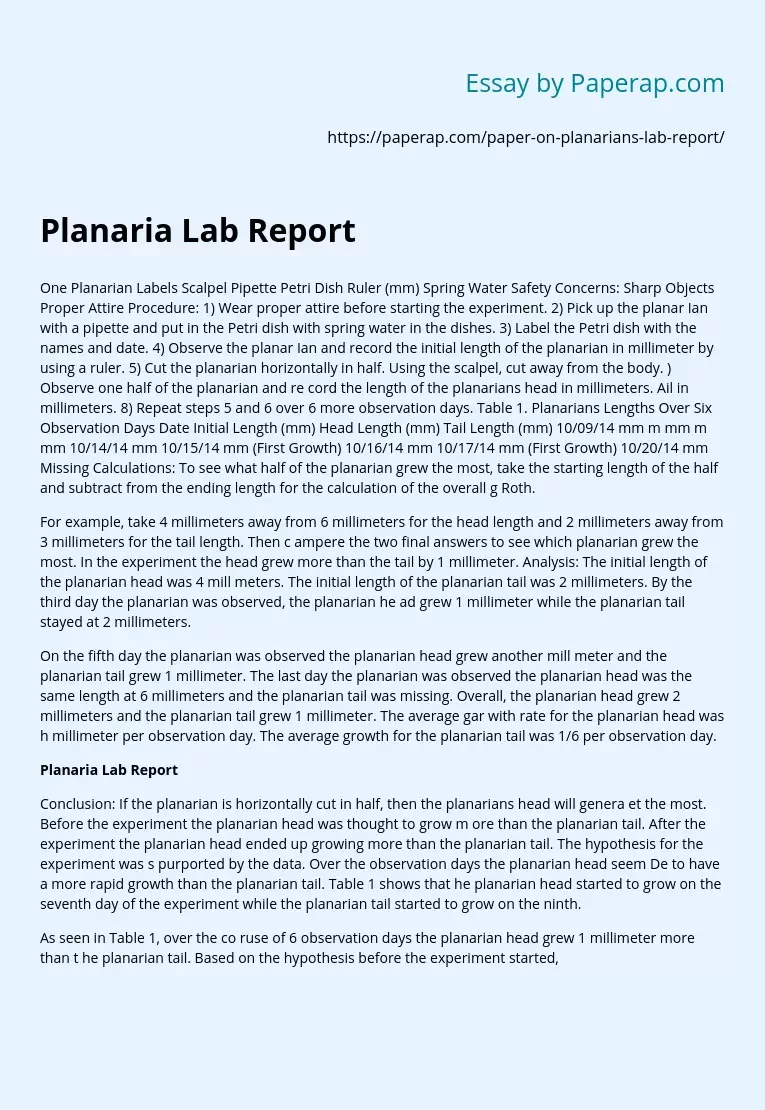Planaria Lab Report
One Planarian Labels Scalpel Pipette Petri Dish Ruler (mm) Spring Water Safety Concerns: Sharp Objects Proper Attire Procedure: 1) Wear proper attire before starting the experiment. 2) Pick up the planar Ian with a pipette and put in the Petri dish with spring water in the dishes. 3) Label the Petri dish with the names and date. 4) Observe the planar Ian and record the initial length of the planarian in millimeter by using a ruler. 5) Cut the planarian horizontally in half. Using the scalpel, cut away from the body.
) Observe one half of the planarian and re cord the length of the planarians head in millimeters. Ail in millimeters. 8) Repeat steps 5 and 6 over 6 more observation days. Table 1. Planarians Lengths Over Six Observation Days Date Initial Length (mm) Head Length (mm) Tail Length (mm) 10/09/14 mm m mm m mm 10/14/14 mm 10/15/14 mm (First Growth) 10/16/14 mm 10/17/14 mm (First Growth) 10/20/14 mm Missing Calculations: To see what half of the planarian grew the most, take the starting length of the half and subtract from the ending length for the calculation of the overall g Roth.
For example, take 4 millimeters away from 6 millimeters for the head length and 2 millimeters away from 3 millimeters for the tail length. Then c ampere the two final answers to see which planarian grew the most. In the experiment the head grew more than the tail by 1 millimeter. Analysis: The initial length of the planarian head was 4 mill meters. The initial length of the planarian tail was 2 millimeters. By the third day the planarian was observed, the planarian he ad grew 1 millimeter while the planarian tail stayed at 2 millimeters.
On the fifth day the planarian was observed the planarian head grew another mill meter and the planarian tail grew 1 millimeter. The last day the planarian was observed the planarian head was the same length at 6 millimeters and the planarian tail was missing. Overall, the planarian head grew 2 millimeters and the planarian tail grew 1 millimeter. The average gar with rate for the planarian head was h millimeter per observation day. The average growth for the planarian tail was 1/6 per observation day.
Planaria Lab Report
Conclusion: If the planarian is horizontally cut in half, then the planarians head will genera et the most. Before the experiment the planarian head was thought to grow m ore than the planarian tail. After the experiment the planarian head ended up growing more than the planarian tail. The hypothesis for the experiment was s purported by the data. Over the observation days the planarian head seem De to have a more rapid growth than the planarian tail. Table 1 shows that he planarian head started to grow on the seventh day of the experiment while the planarian tail started to grow on the ninth.
As seen in Table 1, over the co ruse of 6 observation days the planarian head grew 1 millimeter more than t he planarian tail. Based on the hypothesis before the experiment started, the e planarian head was thought to grow more than 2 millimeters overall. The plan rain tail grew 1 millimeter overall concluding that planarian head grew the most. Further Studies: In the experiment two questions arose. What were to happen if the pal naira were in different types of liquids such as spring water or spring eater with vinegar? Would the planarian still live in different environ moments?
If the planarian is put into a Petri dish with vinegar, then the planarian will still be able to live. Limitations: One limitation in this experiment could have been human error. The SST dents could have spilt the water out of the Petri dishes and could have 10 SST one of the planarian. If the water was spilt then the data would be oaf acted because the students would no longer have one of the planarians and would have to start a new data table for a new planarian. To prevent FRR mom spilling the students could have done the experiment in the same place w ere the students kept the planarian.
Planaria Lab Report. (2019, Dec 05). Retrieved from https://paperap.com/paper-on-planarians-lab-report/

